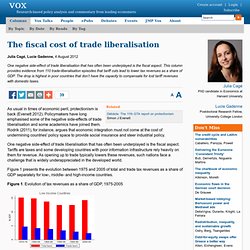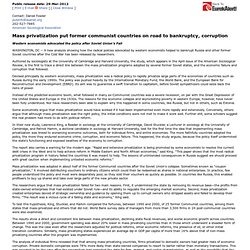

What Are Structural Reforms? Noah Smith and Paul Krugman both argue that support for austerity in the slump is at least partially a product of desire for structural reforms.

Smith notes: "I conjecture that “austerians” are concerned that anti-recessionary macro policy will allow a country to “muddle through” a crisis without improving its institutions. In other words, they fear that a successful stimulus would be wasting a good crisis. " Of course, "structural reforms" mean a lot of things to a lot of people because in the broadest sense "structural reforms" simply mean changes to the economic-governmental structure. The IMF structural adjustment programs offer loans to developing nations typically in exchange for political changes such as privatisation, deregulation and the reduction of trade barriers.
The proponents of immediate austerity in many cases believe that stimulus will actively make things worse.
The fiscal cost of trade liberalisation. As usual in times of economic peril, protectionism is back (Evenett 2012).

Policymakers have long emphasised some of the negative side-effects of trade liberalisation and some academics have joined them. Rodrik (2011), for instance, argues that economic integration must not come at the cost of undermining countries' policy space to provide social insurance and steer industrial policy. One negative side-effect of trade liberalisation that has often been underplayed is the fiscal aspect.
Tariffs are taxes and some developing countries with poor information infrastructure rely heavily on them for revenue. As opening up to trade typically lowers these revenues, such nations face a challenge that is widely underappreciated in the developed world. Figure 1 presents the evolution between 1975 and 2005 of total and trade tax revenues as a share of GDP separately for low-, middle- and high-income countries. Figure 1. Mass privatization put former communist countries on road to bankruptcy, corruption. Public release date: 29-Mar-2012 [ Print | E-mail Share ] [ Close Window ] Contact: Daniel Fowlerpubinfo@asanet.org 202-527-7885American Sociological Association WASHINGTON, DC -- A new analysis showing how the radical policies advocated by western economists helped to bankrupt Russia and other former Soviet countries after the Cold War has been released by researchers.

Authored by sociologists at the University of Cambridge and Harvard University, the study, which appears in the April issue of the American Sociological Review, is the first to trace a direct link between the mass privatization programs adopted by several former Soviet states, and the economic failure and corruption that followed. Devised principally by western economists, mass privatization was a radical policy to rapidly privatize large parts of the economies of countries such as Russia during the early 1990s. Bankwatch. The Politics of Money in the World Economy. Private profit for public good? Can investing in private companies deliver for the poor? Donor governments and multilateral institutions have provided grants and loans to private companies operating in developing countries for decades.

However, since the 1990s the scale of this support has increased dramatically. In 2010 external investments to the private sector by IFIs exceeded $40 billion. By 2015, the amount flowing to the private sector is expected to exceed $100 billion – making up almost one third of external public finance to developing countries. As global ODA stagnates, several aid agencies have suggested a dramatic scaling up of public finance devoted to supporting private sector investments. Using ODA for private sector investment is contentious among civil society organisations. This report assesses whether external (non-domestic) public finance for private investments in the South lives up to promises to provide finance to credit-constrained companies in developing countries and to deliver positive development outcomes. This report is also available in Spanish. Structural adjustment in the Middle East: Success or failure? 'Development'... Dreamland: The Neoliberalism of Your Desires.
Neoliberalism is a triumph of the political imagination.

Its achievement is double: While narrowing the window of political debate, it promises from this window a prospect without limits. On the one hand, it frames public discussion in the elliptic language of neoclassical economics. The collective well-being of the nation is depicted only in terms of how it is adjusted in gross to the discipline of monetary and fiscal balance sheets. On the other, neglecting the actual concerns of any concrete local or collective community, neoliberalism encourages the most exuberant dreams of private accumulation -- and a chaotic reallocation of collective resources. In Egypt, such modes of thinking have defined the 1990s as a decade of remarkable success and a vindication of neoliberal principles. The development tracts spreading out across the fields and deserts around Greater Cairo represent the most phenomenal real estate explosion Egypt has ever witnessed. Building Trade Undisciplined Capital. Quo vadis neoliberalism?
The IMF.